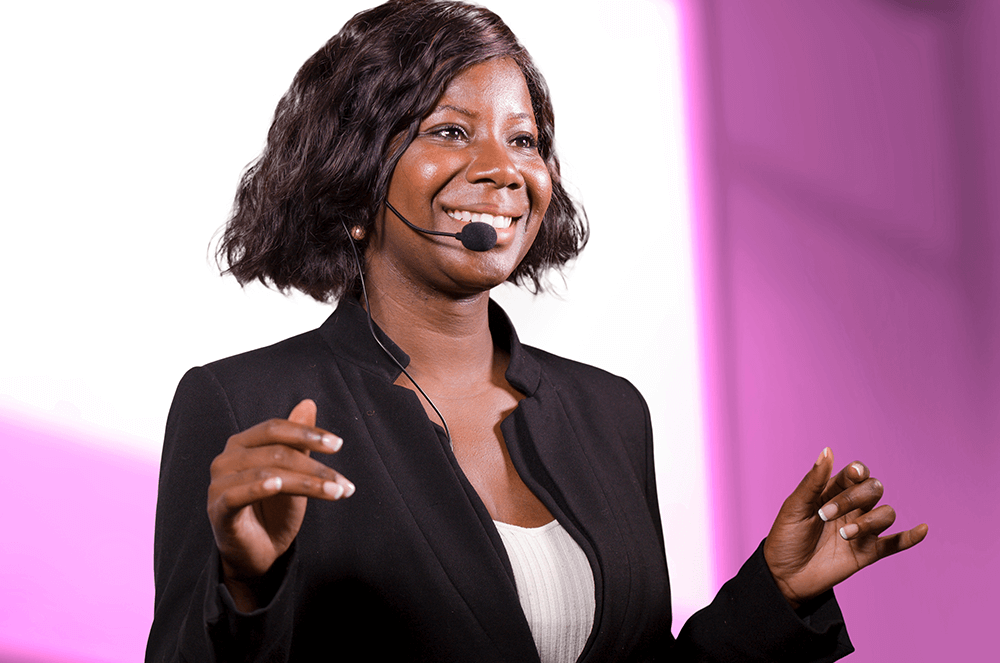
A late start, a lame introduction, an inappropriate joke—any blunder can ruin the best of speeches. Seasoned Toastmasters likely know this, but we’ve had a peculiar few years and might need a refresher. Most of us have gotten more used to talking to a camera from our bedrooms than actually standing in front of an audience in person. Some Toastmasters have never experienced any offline meetings at all. Time to dust off our people skills and brush up on how to behave on an actual stage in front of real human beings.
Susanne Abplanalp has been teaching groups and individuals within corporations and adult education institutions in Switzerland for years and is a specialist on manners, form, and etiquette. Here’s what this business etiquette expert has to say about the perfect public appearance:
1 Preparation, Preparation, Preparation
When preparing your speech, whether online or in person, ask yourself a few questions. Who’s your audience? What occupies their minds at the moment? What level of expertise can you expect? How do you hook their attention right from the start? Tailor your content as closely as you can to your audience and their line of business.
If in doubt: Never assume anything, explain everything, and use intelligible, easy-to-understand language. The more background information you share, the more value your content will have for the audience.
When speaking in person, you want to take some additional steps before you go onstage. Good preparation includes a Plan B: What will you do when faced with a technical glitch or when your speaking time gets cut short? Think through the different scenarios of what could go wrong and consider what you can do ahead of time to prevent them. Prepare a checklist.
You can’t plan for all emergencies, of course. Should something unexpected happen in spite of all your preparation, you can make up for it with a bit of humor.
2 You’re Onstage Even When You’re Not
Be true to your authentic self. You want to transmit the same values as a person and a speaker. Behave in a professional and polite manner even when you’re just parking your car or entering the elevator. Make sure your audience can feel that you practice what you preach.
Arrive 60 minutes before the event. Allow plenty of time to get to the venue, find the right room, and talk to your host and the person who will introduce you. Set up your technical devices and check the agenda for last-minute changes. If possible, put your notes on the lectern. Double-check that your microphone and projector are working properly.
3 Punctuality Is King
Arriving early and getting accustomed to the room, your host, and your audience allow for plenty of time to calm down, take a deep breath, and even practice some power poses.
Start on time. If members of the audience are late, acknowledge them with a friendly nod of your head without interrupting your presentation.
Always keep to your allocated speaking time. If you go too long, you’ll cause problems for your host and test your audience’s patience.
4 Greetings and Introductions
Ideally, your host or the master of ceremonies will introduce you. And most often, you’ll be the person to either offer them the ideas of what you would like them to say, or you will write something for them yourself. Think carefully about how you would like to be described and what expertise you would like highlighted for this specific occasion. Discuss it with the person who introduces you ahead of time. A handshake or other greeting (a nod of the head, perhaps) onstage is always initiated by the host or emcee. If they don’t offer a physical greeting, start your talk without one.
You want to transmit the same values as a person and a speaker.
It’s showtime! Enter the stage energetically and keep your hands out of your pockets. Tell your audience what to expect, how long your presentation will be, whether there’ll be breaks, and whether they’ll be provided with a handout. This might feel very different from the online meetings we have all gotten used to. Remember: Being nervous is a normal reaction when you are suddenly faced with a room full of strangers, but keep in mind that your audience is there to see you and is eager to hear what you have to say.
5 Fine Feathers Make Fine Birds
Your clothing, hair, accessories, etc., should match the occasion as well as your personal style. It signals your appreciation to have been invited as a speaker. Keep in mind that this is not a Zoom presentation—you are visible in 3-D. Time to ditch the pajama pants!
Plain colors are usually easier on the eye than stripes or patterns. The human eye reacts to light, so wearing light colors close to your face can help.
People will now be able to see your full body—not just your shoulders and above. Make sure to avoid anything that might distract your audience’s attention, such as missing, open, or gaping buttons, creases and wrinkles, sweat stains, trouser legs that are too short or too long, and worn-down shoes. On the other hand, don’t overdo it either. Flashy outfits and shiny, sparkling, or dangling jewelry can be just as distracting.
Make sure your hair is neatly in place. It can be difficult to focus on what you are saying if your hair keeps covering part of your face.
6 Authentic Body Language
Make sure your audience feels your enthusiasm, your preparation, and your passion for the subject. Use your gestures and facial expressions accordingly, in a manner that suits the occasion. Speakers who occupy plenty of space and use the stage to their advantage exude confidence. Open gestures and a smile will make you look open-minded and friendly. Employ pauses for extra impact.
You want to avoid scratching, hands in your pockets, touching yourself (e.g., on the face), or playing with your hair, a pen, etc. These kinds of behaviors can distract your audience.
Keep up good eye contact throughout your speech—and don’t forget the people in the back seats. This might be the biggest difference to online meetings: no staring straight at a camera anymore! Try concentrating on one person in one section of the room for 4-5 seconds before moving on to another person in another section.
7 End with a Bang!
Don’t waste the powerful ending of your speech on a faltering “thank you” to the audience. Ideally you will have acknowledged their attentiveness and their questions throughout your whole presentation. Best to end with something memorable: a succinct summary, for instance, or a fiery call to action.
Just as the transition to online speeches was a change in style, returning to (or beginning) in-person speaking requires some additional considerations. As you return to an actual stage, use the space to your advantage with strong body language and appearance. Before long, you’ll feel just as comfortable in 3D as you are in 2D.
Editor’s Note: An earlier version of this article was first published in its original German in Shine, a womenbiz magazine in Zurich.
Susanne Abplanalp and Sonja Bonin Susanne Abplanalp is a business etiquette consultant, a certified persolog© trainer, and the founder and owner of Training & Style. She’s the author of Der Office-Knigge (in German). Sonja Bonin is an Area Director in District 109, and a professional writer, editor, and translator (English-German). Both Susanne and Sonja are based in Switzerland and are members of the trilingual International Lunchtime Toastmasters Club in Zurich.
Related Articles

Presentation Skills
The Power of First Impressions

Presentation Skills
How to Rock Your Presentation

Presentation Skills



 Previous
Previous

 Previous Article
Previous Article